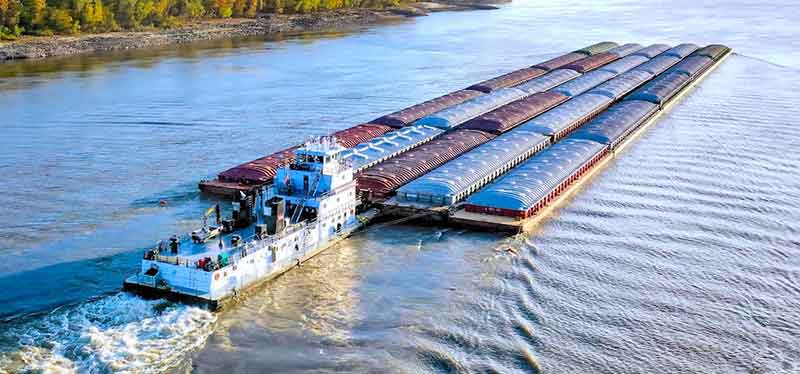When a container ship lost power and struck Baltimore’s Francis Scott Key Bridge on March 2024, it brought one of America’s busiest ports to a halt. Just six days later, a fuel barge ship quietly reopened a critical lifeline, navigating a temporary channel to keep essential cargo flowing.
What is barge in shipping?
Barge shipping uses large, flat-bottomed vessels to move bulk goods through rivers, canals, and coastal waters. These cargo barges are built for capacity. Unlike ocean freighters, a shipping barge can access shallow or narrow inland routes, which means you can reach remote terminals or bypass congested ports.

Types of barges used in modern shipping
Barges come in various forms; choosing the suitable barge ship depends on the cargo type, destination, and waterway limitations.
Dry cargo barges
These cargo barges handle bulk solids, including grain, coal, steel, and sand. They’re a staple in barge freight, offering massive capacity for industries that need to move raw materials efficiently across long distances.
Liquid cargo barges
Built for fluids, these shipping barges transport petrochemicals, industrial chemicals, and fertilizers. They’re commonly used along rivers connected to refineries and manufacturing plants, helping streamline liquid bulk supply chains.
Split hopper barges
Essential for marine construction, split hopper barges carry dredged mud or sand and can unload directly into the sea or at designated drop zones. They’re widely seen in port deepening or coastal restoration projects.
Specialty Barges
You may also encounter power barges (floating power stations) or ceremonial royal barges in specific cultural or industrial settings.
What is a barge ship used for?
Barge shipping supports multiple sectors with flexible, high-volume capabilities:
Cargo transport
Cargo barges move goods between ports and larger vessels, especially where deep-draft ships can’t reach. They carry a wide range of cargo, from containers to bulk freight. As most barges lack onboard cranes, they rely on dockside equipment commonly used in major ports, such as Rotterdam and Shanghai.
Port services
Shipping barges also support port operations by delivering supplies, removing waste, and assisting with maintenance tasks.
Emergency response
Barges also assist in maritime emergencies, handling oil spills, recovering cargo, or supporting damaged ships.
Marine construction
Freight barges play a crucial role in marine engineering, supporting tasks such as laying pipelines and transporting equipment for offshore projects. Their flat decks provide a stable, mobile work platform.
How many shipping containers fit on a barge?
The number of containers a barge can carry depends on its size, load capacity, and the type of container (e.g., TEU or FEU units). Here’s a general idea based on standard shipping barge dimensions:
- 180-foot barge: Carries up to 2,000 metric tons, or roughly 90–100 TEUs.
- 230-foot barge:Handles about 4,000 metric tons, fitting 180–200 TEUs.
- 270-foot barge:Supports 6,000 metric tons, holding 270–300 TEUs.
- 300-foot barge: Transports up to 8,000 metric tons, around 360–400 TEUs.
- 400-foot barge:The heavyweight, moving 10,000 metric tons, with a capacity for 450–500 TEUs.
Of course, actual capacity depends on how the containers are stacked and whether the barge operates on rivers, coastal waters, or open seas. On inland routes, like the Mississippi or Yangtze River, cargo barges typically haul containers in a single layer for stability. In contrast, ocean-going shipping barges may stack multiple tiers if the design allows.
Barge vs cargo ship: Which fits your freight plan?
When weighing barge vs cargo ship options, think beyond size. Each vessel excels on different routes and cargo profiles, so matching them to your supply chain can trim costs and transit time.
| Key Factor | Barge Ship | Cargo Ship |
|---|---|---|
| Typical Load | 90–500 TEU on inland or coastal runs | 2,000–24,000 TEU for deep-sea lanes |
| Draft & Route | Flat bottom, shallow draft—perfect for rivers, canals, and ports with depth limits | Deep draft—built to cross oceans and handle heavy swells |
| Propulsion | Tug-pushed or towed; lower fuel burn per ton | Self-propelled with large engines; faster but costlier to run |
| Speed | 5–8 knots—ideal when time is flexible | 16–22 knots for time-sensitive trade lanes |
| Versatility | Often task-specific: grain, fuel, oversized project cargo | Handles containers, break bulk, and Ro-Ro on long haul routes |
| Cost & Emissions | Low barge freight rates; smallest carbon footprint per ton-mile in barging shipping | Higher operating cost but economies of scale on ocean crossings |
Advantages of barge shipping for shippers
- Lower cost per ton-mile: A cargo barge burns far less fuel than trucks or rail, so barge freight rates stay competitive even when fuel prices climb.
- Greener footprint: Barging shipping generates the fewest CO₂ emissions per ton of any commercial transport mode.
- Inland reach: Shallow-draft barge ships access river terminals hundreds of miles from the coast, easing congestion at deep-sea ports and trimming drayage fees.
Practical tips for first-time barge users
- Book early: Sailing schedules are weekly, not daily; secure space before peak harvest or construction season.
- Know your draft limits: Check water depth at each lock and landing to avoid last-minute cargo lightening.
- Bundle volume: Combine multiple 20-foot containers into one move to maximize deck space and cut barge freight rates.
- Line up lift gear: Most shipping barges rely on shore cranes; therefore, confirm equipment and time slots with the terminal.
- Partner with pros: Choose a forwarder who can stitch barge legs into ocean and rail routes for door-to-door coverage.
Conclusion
Barge and cargo ship aren’t an either-or debate; the prescient supply chains use both. Airsupply (ASLG) integrates barge, ocean, and container services on a single platform. Our team negotiates competitive barge freight rates, arranges quay cranes, and provides real-time tracking from the river pier to the final port. With in-house customs brokers and 24/7 support, ASLG turns complex multimodal moves into a single, seamless invoice.




